Thursday, April 26, 2012
The List - Roses in my Garden
For those who live nearby I could offer some cuttings.
Just choose from my list of roses and leave a message.
I'll be more than happy to see the population of roses growing.
Anything, for a flowery world!
Acestia sunt trandafirii din gradina mea.
Celor care locuiesc in apropiere le pot oferi butasi.
Doar alegeti din lista si lasati un mesaj.
Voi fi foarte fericita sa vad populatia de trandafiri crescand.
Orice, pentru o lume mai inflorita! :)
Gallica / Moss / Damask / Centifolia / Alba
- Leda
- Great Maiden's Blush / Cuisse de Nymphe
- Konigin von Denmark
- Felicite Parmentier
- Belle Isis
- Nuits de Young
- Omar Khayyam
- Gallica Officinalis
- Ispahan
- Kazanlik
- Quatre Saisons
- Fantin-Latour
- Centifolia
- Alba Maxima
Climbers
- Crimson Glory
- Madame Isaac Pereire
- Gloire de Dijon
- Marechal Niel
- Guinee
English Roses
- Jude the Obscure
- Lady Emma Hamilton
- Scepter d'Isle
- Summer Song
All the others - Remontants
- La France
- Viridiflora
- Rose de Rescht
- Comtesse Cecile de Chabrillant
- La Reine
- Louise Odier
- Baron Girod de l'Ain
- Comte de Chambord
- Louis XIV
- Reine des Violettes
- Hansa
- Stanwell Perpetual
- Baccara
- Chrysler Imperial
I have also some other roses, but they are still too young to have cuttings from them. Watch them grow and ask later :)
- Rhapsody in Blue
- Abraham Darby
- Caprice de Meilland
- Harlequin
- Golden Gate
- Dune
- Laguna
- Ilse Krohn Superior
- Rosarium Uetersen
There are also some unknown roses. I will ask your opinion on them, maybe we'll be able to find their names. Later.
Wednesday, April 18, 2012
Intoxicating Fragranced Roses - Nuits de Young



Friday, March 30, 2012
Intoxicating Fragranced Roses - Caprice de Meilland


 "Caprice de Meilland" bred, obviously, by Meilland :) in 1997.
"Caprice de Meilland" bred, obviously, by Meilland :) in 1997.Very fragrant bengal pink.
Height : 100 cm - bloom size : 12 cm diameter on av.
Award for Fragrance Bagatelle 1997
Award for fragrance Geneva 1997
Gold Medal Hybrid Teas Roma 1997
Award for fragrance Roma 1997
Blooms in flushes throughout the season.
Zone 7. Can be used for cut flower. Heat tolerant. Requires spring freeze protection.
With so many awards for its scent, how do you think it smells? I tell you, just wonderful...
Intoxicating Fragranced Roses - Summer Song
Tuesday, March 27, 2012
Intoxicating Fragranced Roses - Rosa Centifolia

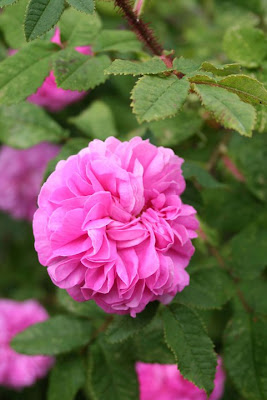
Probably originated in the Caucasus and first cultivated in Persia, it is said to have reached Britain in 1596 and has been used since in hybridizing and for its delightful fragrance.
Nowadays this rose is cultivated widely (mostly in the south of France and Morocco) to supply the perfume industry with attar of roses.
The full, globular, deep glowing pink flowers have numerous petals becoming darker towards the centre and appear in early to mid-summer (once-flowering). They are arranged in small clusters and emerge from tight feathery buds. They are flattish, very double and very fragrant.
The bushy, well-branched shrub can attain a height between 5' to 6' 11" (150 to 210 cm) in good soil and the width is up to 5' (150 cm), producing long strong shoots with numerous reddish thorns and prickles. Its leaves are coarse, both in appearance and to touch, and are grayish green. The zone were it thrives is from 4 to 9.
You can use the intoxicating fragranced petals in many recipes, as salads, jam, syrup, tea or potpourri. And, of course, it has such a vintage charm in the garden…
Monday, March 26, 2012
Intoxicating Fragranced Roses - La France


Sunday, March 18, 2012
Intoxicating Fragranced Roses - Jude The Obscure


"Its flowers are very large and of incurved chalice shape. Their color is a pleasing medium yellow on the inside of the petals and a paler yellow on the outside.
It has excellent, strong and almost completely disease-free growth. This rose is particularly fine in a dry climate, although it may ball in the rain.
A very strong, unusual and delicious fragrance with a fruity note reminiscent of guava and sweet white wine.
Named after the character in Thomas Hardy’s novel.
4 ft. x 4 ft. or 8 ft. as a climber ".
We simply can't argue with Mr. Austin. This rose is indeed magnificent.
So:
- shrub English Rose Collection
- medium yellow, apricot, cream shading colour, lighter reverse.
- 55 to 70 petals.
- full, borne mostly solitary or in small clusters, globular bloom form.
- blooms in flushes throughout the season.
- height of up to 4' (up to 120 cm)
- width of up tp 4' (up to 120 cm).
- as a climber - 8' or 250 cm.
- very disease resistant indeed.
- Zone 5 to 10.
Use minimal pruning, otherwise the growth will be diminished.Sunday, March 11, 2012
Intoxicating Fragranced Roses: Rosa Damascena Bifera / Autumn Damask / Quatre Saisons




Wednesday, March 7, 2012
Intoxicating Fragranced Roses - Reine des Violettes




Monday, March 5, 2012
Roses for Shady Locations
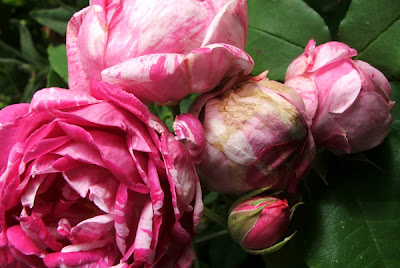
Monday, February 27, 2012
Intoxicating Fragranced Roses - Star of the Nile



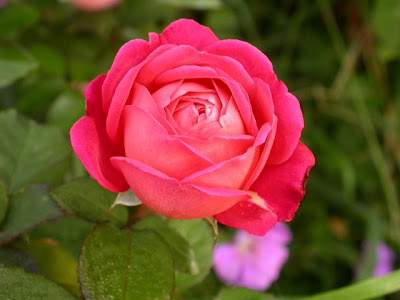
Monday, February 20, 2012
Rosa Gallica


Synonyms: Red Rose, French Rose, Rosier de France, Rose de France, Rosa Rubra, Rose of Miletus (Pliny).
It is a deciduous shrub forming large patches of shrubbery, the stems with prickles and glandular bristles. The leaves are pinnate, with three to seven bluish-green leaflets. The flowers are clustered one to four together, single with five petals, fragrant, deep pink. The hips are globose to ovoid, 10–13 mm diameter, orange to brownish.
The species is easily cultivated on well drained soil in full sun to semishade; it can survive temperatures down to −25 °C. It is one of the earliest cultivated species of roses, being cultivated by the Greek and Romans and it was commonly used in Mediaeval gardens. It has been used for medicinal purposes ever since its birth and it is also part of the story of the War of the Roses.
... And it has an intense fragrance...
The Gallica Group roses share the vegetative characters of the species, forming low suckering shrubs. The flowers can be single, but most commonly double or semidouble. The colours range from white (rare) to pink and deep purple.
Rosa Alba Maxima

 This beautiful rose is one of the most subtle and simple of the Albas, and yet also a sophisticated shrub of great character. Also known as the 'Jacobite Rose', or the 'White Rose of York'.
This beautiful rose is one of the most subtle and simple of the Albas, and yet also a sophisticated shrub of great character. Also known as the 'Jacobite Rose', or the 'White Rose of York'.The shrub form is upright and arching, or fountain shaped.
The foliage is typical of the Albas: grey-green and dark, generally disease free, although rarely this rose will get rust.
Blooms are white when fully open, but depending on the weather, they will have a cream or blush pink tone at the center at the beginning. They are produced in small clusters of 3 or as many as 8, and are very strongly, and sweetly scented.
R. alba maxima is not an ordinary rose....it is a sublime beauty that works very well in cottage gardens. Just remember that Albas are best left unpruned so that they may develope their true shrub form, so don't plant one unless you can allow it the room to grow as it pleases.
Alba Roses are hybrids whose antiquity may go back further than the Roman Empire. Plinius, who lived from 23-79 A.D., mentioned white roses in his Natural History. Botanists believe these roses may have been Albas.
Graham Thomas supports Dr. C. C. Hurst's theory that Albas are derived from the dog rose, Rosa canina, and the Damask rose, Rosa damascena. Others say it's born from Rosa canina and Rosa gallica.
They have a penetrating pure rosy fragrance with tones of citrus.
They are resistant to disease for the most part. Many can tolerate shade, drought, and are winter hardy.
Many prominent artists including Botticelli, Luini, Crivelli, Shoengauer, da Zevio and van Spaendonck illustrated Albas.
Zone 3 to 9
Rosa Foetida Persiana

The same characteristics as Rosa Foetida.
The Swedish Rose Society recommends Rosa Feotida Persiana for northern Sweden.
Sunday, February 19, 2012
Rosa Banksiae

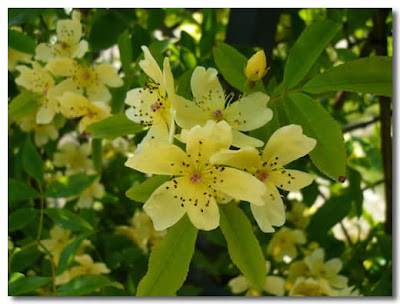
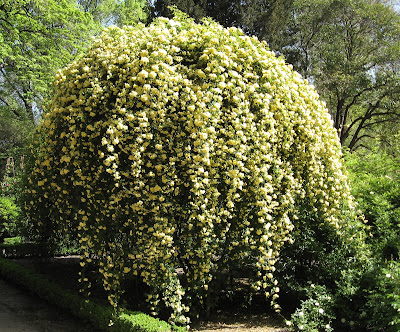

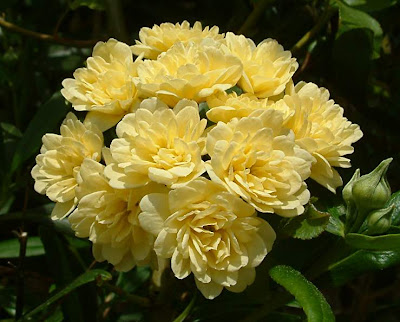
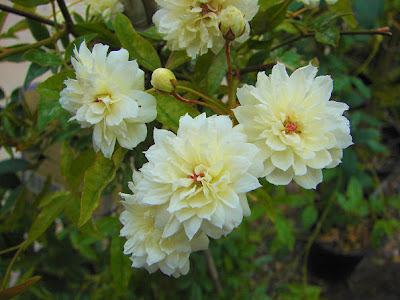
There are several varieties, the most known are:











